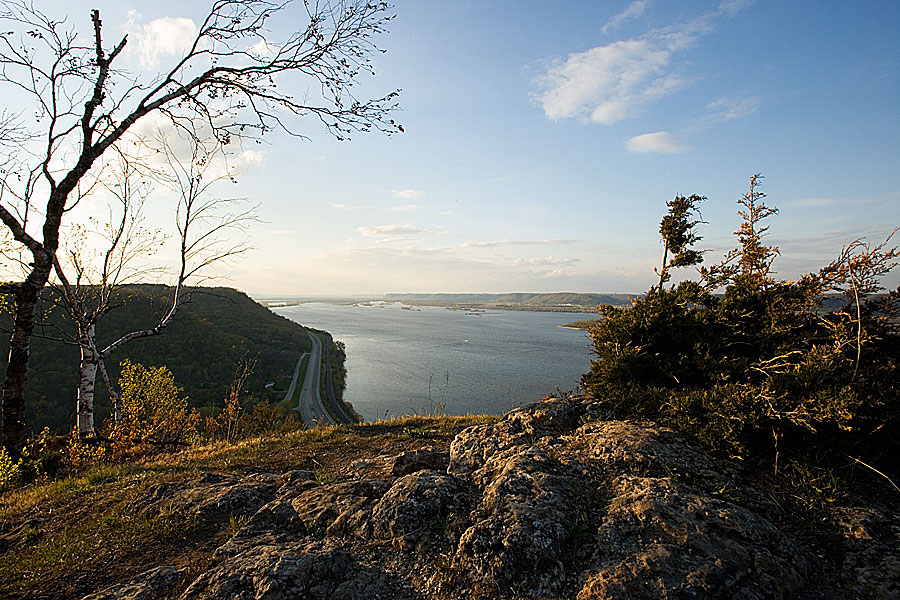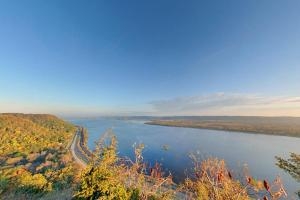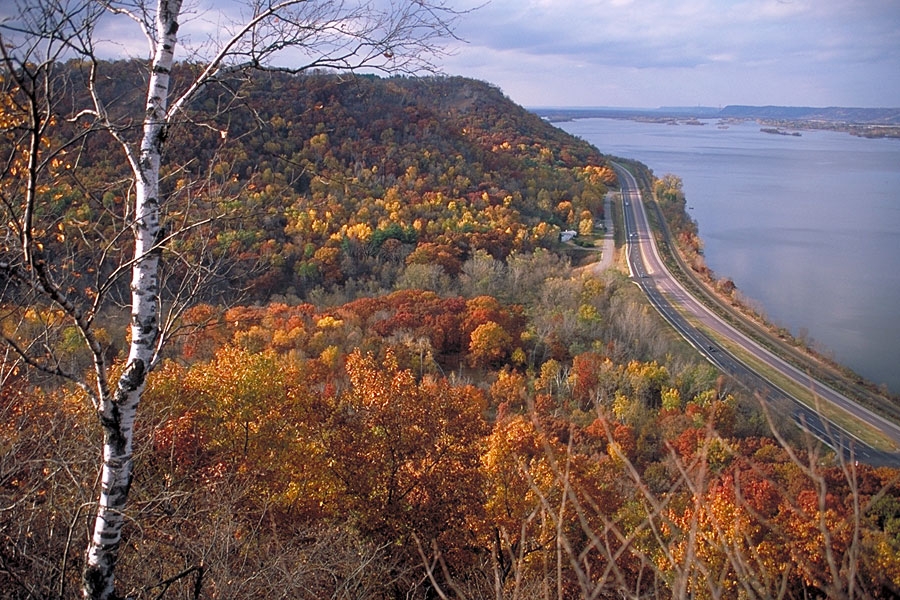


Chimney Rock – Whitewater State Park
19041 Highway 74, Altura, MN 55910
Coordinates: 44.06147387564574° N, -92.04708252353316° W
Chimney Rock provides a panoramic view of the valley while offering an ideal location for park naturalists to share about the unique geologic history of the park. The prominent cliffs are made mostly from the resistant Oneota Dolostone that underlies much of this area. The movement of mildly acidic groundwater has dissolved the bedrock and created a number of karst features that can be seen in the cliff faces. The Chimney Rock trail has the most accessible exposures of the 500-million-year-old bedrock in the park. The small hole at the base of the pinnacle is an example of the cavities through which ground water travels where the Oneota lies beneath the land surface. Across the valley toward the west side of the river you may see some caverns at the base of the bluffs. Some north facing caves in the blufflands contain ice year round because their openings receive no direct sunlight for most of the day, and they are insulated by surrounding rock from the warm outside air in the summer.
Any fees?: No, but a State Park vehicle permit is required
Accessible?: No
Dog Friendly?: Yes
Time to Complete: 45 minutes
Distance: 0.7 Mile (roundtrip), 220ft elevation gain
Difficulty: Difficult
Maintained by: The Minnesota Department of Natural Resources
More Info:
https://www.dnr.state.mn.us/state_parks/park.html?id=spk00280#homepage
http://files.dnr.state.mn.us/destinations/state_parks/virtual_tours/whitewater/vt_whitewater.html
https://conservancy.umn.edu/bitstream/handle/11299/57274/MGS_ES_9.pdf
Stream Sink – Whitewater Wildlife Management Area
Winona County Road 37, Altura, MN, 55910
Heading Southwest along County Road 37, the Stream Sink can be seen close to the road on the right after passing the MN Department of Natural Resources Crystal Springs Trout Hatchery.
Coordinates: 44.071052° N, -91.990742° W
Located in the Wildlife Management Area along Winona County Road 37, about a 1/8 mile southwest of the Crystal Springs Trout Hatchery, a spring-fed stream disappears underground through a series of sinking points in the rock layers below (Prairie du Chien through the St. Lawrence). Surface water in this region can sink quickly into the aquifer underground carrying pollutants to our drinking water and to springs such as the one that feeds the nearby trout hatchery. Hydrologists use dye-tracing to study the underground movement of water from sinking streams and sinkholes. The discovery of St. Lawrence stream sinks such as the one at this site that connect to conduits conveying water to springs, is a major achievement made by hydrologists in the last decade or so. Research is ongoing in an effort to better predict, detect and contain groundwater contamination caused by human activity.
This stream sink changes location depending on precipitation. You may have to walk upstream to observe the sink location during dry spells. Likewise, you may have to walk downstream to observe the sink location during wet spells. After snow melt or heavy rain events, the stream may not totally disappear at all.
Any fees?: No, it’s free!
Accessible?: No
Dog Friendly?: Yes
Time to Complete: 30 minutes
Distance: 500-2,500 ft
Difficulty: Easy (climbing up and out of stream bed will occur)
Maintained by: The Minnesota Department of Natural Resources
More Info:
https://www.dnr.state.mn.us/waters/groundwater_section/mapping/springs.html
https://conservancy.umn.edu/handle/11299/188688
https://www.youtube.com/watch?v=qHHolyR6qKo&feature=youtu.be
Enterprise Rest Area
I-90, Lewiston, MN, 55952
Coordinates: 43.9315895703227° N, -91.85273048722219° W
This rest area is located between the Dresbach Welcome Center and Whitewater State Park and provides beautiful views of the Driftless Area. An interpretive sign describes the geology of Southern Minnesota. From the overlook, visitors can view a valley carved into the karsted Prairie du Chien Group carbonate bedrock. Driving down into the valley over Rush Creek look for solution voids in the bedrock. Dissolution of the carbonate bedrock is one of the two main forces for the creation of the landscape here. Erosion by the surface streams is visible along this valley. This stream, Rush Creek, moves across its valley in response to flood events. If you come back in a year or two the stream may have moved!
Any fees?: No, it’s free!
Accessible?: Yes
Dog Friendly?: Yes
Time to Complete: 15 minutes
Distance: 1/4 Mile
Difficulty: Very Easy

John A. Latsch State Park
Highway 61, Minnesota City, MN 55959
Coordinates: 44.172549° N, -91.838344° W
John A. Latsch State Park is directly off of Hwy. 61, the Great River Road, a few miles north of Winona. Begin your hike at the parking lot, following the signs for the Riverview Trail. This strenuous half-mile hike up to the top of Mount Charity includes 592 stairs, but your reward at the end is worth it. From this vantage point visitors are greeted with a grand long view of the Mississippi River Valley and Driftless Area landscape. Mount Charity is one of three bluffs, Faith and Hope being the other two, which are an extension of a Cambrian and Ordovician aged limestone cap that once extended across the river into Wisconsin. Tremendous volumes of water flowing from regional glacial lakes dissected the valley by way of stream erosion from glacial Mississippi River.
Any fees?: No (State Park Vehicle permit required)
Accessible?: No
Dog Friendly?: Yes (leashed)
Time to Complete: 1 hour
Distance: 0.5 Miles (592 Stairs)
Difficulty: Strenuous
Maintained by: The Minnesota Department of Natural Resources
More Info:
https://www.dnr.state.mn.us/state_parks/park.html?id=spk00160#homepage
https://www.conservancy.umn.edu/bitstream/handle/11299/93782/17-JohnLatch.pdf?sequence=1&isAllowed=y
White Pine Forest Relic
Whitewater State Park, 19041 Highway 74, Altura, MN, 55910
Coordinates: 44.11045621681722° N, -92.17029922416152° W
Although recent glaciers retreated before reaching this region, their meltwaters scoured the many river valleys of the area, leaving behind a landscape entrenched with deep valleys and steep hillsides. Upon close observation of these valleys one will note the different aspect, or exposure, of each bluff face. Upon the south-facing hillsides we find steep, dry prairies, known as goat prairies. These south-facing hillsides are warmer and tend to green up faster in the spring and maintain green vegetation later in the fall. On the north-facing hillsides we observe steep, cool forests which support many relic plant and animal communities able to survive in the cool, shaded forests. On a spring day, you might notice snow blanketing the northern side of a bluff while the southern side is barren of snow and sprinkled with early wildflowers.
One relic plant community of the cooler, north-facing bluffs is the eastern white pine forest. For thousands of years, these pines have survived in small clusters on the cool, rocky north-facing slopes throughout the region. They are drought tolerant and provide important cover for birds and wildlife. These pine forests are characterized by northern species otherwise absent in southeastern Minnesota including balsam fir, yellow birch, Canada yew, nodding wild onion and slender cliff brake.
The land for Carley State Park was donated to the State of Minnesota in 1948 by State Senator James A. Carley and the Ernestina Bolt family in hopes of preserving the outstanding grove of native white pines. In 1957, a severe hailstorm ravaged the trees. Today, white pines tower the steep, rugged valley of the Whitewater River. Park at the Picnic Area lot and walk a couple hundred feet along the river to see pines from below. Or park in the upper lot near the flag pole and hike the trail .15 miles to the observation platform where you can view a stand of pines from across the river.
Any fees?: No (State Park Vehicle permit required)
Accessible?: No
Dog Friendly?: Yes
Time to Complete: 1/2 hour
Distance: 1/3 Mile (roundtrip)
Difficulty: Easy
Maintained by: The Minnesota Department of Natural Resources
More Info:
https://www.dnr.state.mn.us/state_parks/park.htmlid=spk00130#homepage
http://files.dnr.state.mn.us/destinations/state_parks/virtual_tours/carley/vt_carley.html

Great River Road
This section of the Great River Road National Scenic Byway follows the Mississippi River for 39 miles and takes you to John A Latsch State Park and to the Dresbach Welcome Center. The Mississippi River has spent the last 12,000 years carving cliffs into the ancient rocks. These cliffs of soft, white sandstone (called the St. Peter Sandstone) are the lithified remains of the expansive beaches of an Ordovician sea that covered the mid-west 450 million years ago. A look at these sand grains through a magnifying glass reveals sand that has been washed clean and made perfectly round from millions of years of tidal action. Small holes in these cliffs are produced naturally by wind and rain and provide homes for birds. Larger ones were created by people mining the sand for glass bottle production.
The Mississippi River – Lake Pepin watershed consists of forests, bluff lands, and cultivated lands. The top of the watershed is rolling cropland interspersed by many small tributaries that drop steeply through forested valleys with scattered goat prairies atop cliffs. The tributaries join to form the named streams, which drain directly into the Mississippi River. The watershed is only about 50 miles southeast of downtown St. Paul. As a result, the watershed is subject to development pressures.
More Info:
https://www.pca.state.mn.us/water/watersheds/mississippi-river-lake-pepin
https://www.nps.gov/miss/learn/nature/twingeol.htm